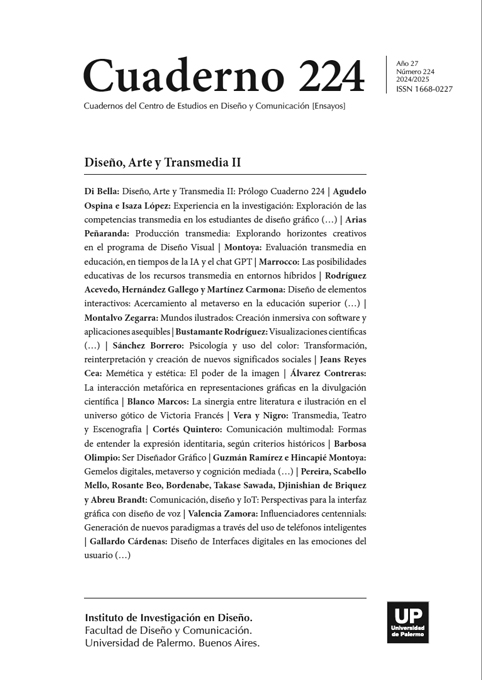Diseño de elementos interactivos: Acercamiento al metaverso en la educación superior en la Institución Universitaria Pascual Bravo, Colombia
Abstract
The current educational context recognises the relevance of design oriented to technological developments, particularly focused on the emerging development of the metaverse.
References
Amarillo, M. A. O. (2004). Apuntes para una Pedagogia del Diseño. ¿Que Es El Diseño Hoy?, 1–20. https://www.icesi.edu.co/disenohoy/memorias/Ovalle.pdf
Argüello Espinosa, J. M. (2013). El proceso de diseño: diseño interactivo. I+D Revista De Investigaciones, 1(1), 44–52. https://doi.org/10.33304/revinv.v01n1-2013005
Article, R., & Narin, N. G. (2021). A Content Analysis of the Metaverse Articles. Journal of Metaverse, 1(1), 17–24. www.secondlife.com
Barráez-Herrera, D. P. (2022). Metaversos en el Contexto de la Educación Virtual. Revista Tecnológica-Educativa Docentes 2.0, 13(1), 11–19. https://doi.org/10.37843/rted.v13i1.300
Binda, N. U., & Benavent, F. B. (2013, October). buscando las ventajas de las diferentes metodologías. Ciencias Económicas, 31(2), 179–188.
Bowman, N. D., Schultheiss, D., & Schumann, C. (2012). “I’m attached, and I’m a good guy/gal!”: How character attachment influences pro-and anti-social motivations to play massively multiplayer online role-playing games. Cyberpsychology, Behavior, and Social Networking, 15(3), 169–174. https://doi.org/10.1089/cyber.2011.0311
Buddeberg, J., Jenny, B., & Willett, W. (2017). Interactive shearing for terrain visualization: an expert study. GeoInformatica, 21(3), 643–665. https://doi.org/10.1007/s10707-016-0283-9
Carvajal, V. B., & Monge, I. F. (2010). Elementos que favorecen la interactividad en un curso virtual. Innovaciones Educativas, 17, 39–47. https://doi.org/https://doi.org/10.22458/ie.v12i17.562
Cobo Romaní, C., & Pardo Kuklinski, H. (2007). Planeta web 2.0. Flacso México.
Cuartas, S. L. D. (2009). Creación. Un acercamiento a la investigación en las artes. Horiz. Pedagogico, 11(1), 87–92.
Denisova, A., Cairns, P., Guckelsberger, C., & Zendle, D. (2020). Measuring perceived challenge in digital games: Development & validation of the challenge originating from recent gameplay interaction scale (CORGIS). International Journal of Human Computer Studies, 137, 1–15. https://doi.org/10.1016/j.ijhcs.2019.102383
Dionisio, J. D. N., Burns, W. G., & Gilbert, R. (2013). 3D virtual worlds and the metaverse: Current status and future possibilities. ACM Computing Surveys, 45(3), 34–37. https://doi.org/10.1145/2480741.2480751
Fernández, I. M. G., Calvo, A. de C., & Fernández, H. S. (2020). Interacción y uso de tecnologías en los procesos de enseñanza y aprendizaje. Educatio Siglo XXI, 38(1), 119–138. https://doi.org/011-23345$4”6$”783)+$9+)&3:4;<=16”$>)%>>)
Frostling-Henningsson, M. (2009). First-Person Shooter Games as a Way of Connecting to People: “‘Brothers in Blood.’” Cyberpsychology and behavior, 12(5), 557–562. https://doi.org/10.1089=cpb.2008.0345
Ganesh, S., Van Schie, H. T., De Lange, F. P., Thompson, E., & Wigboldus, D. H. J. (2012). How the human brain goes virtual: Distinct cortical regions of the person-processing network are involved in self-identification with virtual agents. Cerebral Cortex, 22(7), 1577–1585. https://doi.org/10.1093/cercor/bhr227
Higuerey, E. (2020). Contenido interactivo: cómo promover una experiencia inolvidable a tus usuarios para fidelizarlos. Rockcontent. https://rockcontent.com/es/blog/contenidointeractivo/
Javier, F., Serrano, T., & Whitman, W. (2005). La virtualización de la sociedad. Athenea Difital, 7, 1–11.
Jeon, J. E. (2021). The Effects of User Experience-Based Design Innovativeness on User– Metaverse Platform Channel Relationships in South Korea. Journal of Distribution Science, 19(11), 81–90. https://doi.org/10.15722/jds.19.11.202111.81
Llobera, J., & Boulic, R. (2019). A tool to design interactive characters based on embodied cognition. IEEE Transactions on Games, 11(4), 311–319. https://doi.org/10.1109/ TCIAIG.2017.2755699
Mon, F. M. E., Segura, J. A., & Cervera, M. G. (2014). Diseño de un entorno 3D para el desarrollo de la competencia digital docente en estudiantes universitarios: usabilidad, adecuación y percepción de utilidad / Design of 3D environment to develop pre-service teachers’ digital competence. Revista Latinoamericana de Tecnología Educativa - RELATEC, 13(2), 35–47. http://mascvuex.unex.es/revistas/index.php/relatec/article/view/1443%5Cnhttp://mascvuex.unex.es/revistas/index.php/relatec/article/download/1443/961
Mujica-Sequera, R. M. (2022). El Metaverso como un Escenario Transcomplejo de la Tecnoeducación. Revista Tecnológica-Educativa Docentes 2.0, 13(1), 20–28. https://doi.org/10.37843/rted.v13i1.268
Navarro, D. S. (2013). Metaverso y artista. BRAC- Barcelona Research Art Creation, 1(2), 130–152. https://doi.org/10.4471/brac.2013.06
Petreca, B., Saito, C., Baurley, S., Atkinson, D., Yu, X., & Bianchi-Berthouze, N. (2019). Radically relational tools: A design framework to explore materials through embodied processes. International Journal of Design, 13(2), 7–20.
Rodríguez García, T. C., & Baños González, M. (2011). E-learning en mundos virtuales 3D. Una experiencia educativa en Second Life. Revista ICONO14. Revista Científica de Comunicación y Tecnologías Emergentes, 9(2), 39. https://doi.org/10.7195/ri14.v9i2.39
Romaní, C. C., & Kuklinski, H. P. (2007). Planeta Web 2.0. Inteligencia colectiva o medios fast food.
Sádaba Chalezquer, M. R. (2000). Interactividad y comunidades virtuales en e entorno de la world wide web. In Comunicación y Sociedad (Vol. 13, Issue 1, pp. 139–166). Comunicación y Sociedad.
Salgado-Levano, A. C. (2007). Investigación cualitativa: diseños, evaluación del rigor metodológico y retos. January. Sampieri, R. H., Fernández-Collado, C., & Lucio, P. B. (2006). Metodología de la investigación. https://doi.org/10.1186/s12885-018-4263-3
Seidel, S., Berente, N., Yepes, G., & Nickerson, J. V. (2022). Designing the Metaverse. Proceedings of the 55th Hawaii International Conference on System Sciences |, 6699–6708. https://hdl.handle.net/10125/80151
Silva-Cañaveral, S. J. (2016). La investigación-creación en el contexto de la formación doctoral en diseño y creación en Colombia. Revista De Investigación, Desarrollo E Innovación, 7(1), 49. https://doi.org/10.19053/20278306.v7.n1.2016.5601
Song, H., Chen, F., Peng, Q., Zhang, J., & Gu, P. (2018). Improvement of user experience using virtual reality in open-architecture product design. Proceedings of the Institution of Mechanical Engineers, Part B: Journal of Engineering Manufacture, 232(13), 2264–2275. https://doi.org/10.1177/0954405417711736
Los autores/as que publiquen en esta revista ceden los derechos de autor y de publicación a "Cuadernos del Centro de Estudios de Diseño y Comunicación", Aceptando el registro de su trabajo bajo una licencia de atribución de Creative Commons, que permite a terceros utilizar lo publicado siempre que de el crédito pertinente a los autores y a esta revista.


